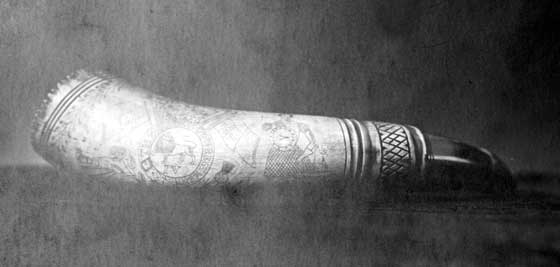Collections
Powder Horns

4th King's Own Regiment Powder Horn, Irish, engraved with emblems of the
King’s Own
Accession Number: KO0587/03 (photograph) object KO1292/01

4th King's Own Regiment Powder Horn, Irish, engraved with emblems of the
King’s Own
Accession Number: KO0587/04 (photograph) object KO1292/01
Powder Horn c. 1799 This bears the regimental badge and a picture of
a Highlander and has an oriental horseman on the other side. The lack of
the shamrock in the wreath below the badge seems to indicate a date
before 1799 when Ireland was brought into the Union with Great Britain.
Powder-Horn, 4th Foot. By H Y Usher
In Regimental Museums in this country one rarely finds an old military
powder horn, though quite a number must have survived.
Their origin dates back to the time of the earliest portable firearms,
the strength and lightness of the horn being eminently suited for the
purpose. Moreover, horns were comparatively easy to obtain even should
replacements be required when on service, as most of the meat supplies
would come alive into the camps.
During the American War of Independence men of the Light Companies
carried powder-horns slung over the left shoulder by means of a cord
which was sometimes merely tied round the horn and sometimes passed
through small eye-rings screwed into the horn itself. When taken into
use the wide end of the horn would be stopped by a disc of wood or by a
metal cap, and the small end by a plug of cork or wood.
From the past numbers of the Journal of the Fort Ticonderoga Museum one
learns of a fine collection of these relics, numbering over 150
examples, now in their possession. In America during the eighteenth
century there were several were known makers of powder horns supplied
for officers’ use, and of bullet horns and rum horns ornamented with
maps engraved thereon: these were called “map horns.” There are,
however, specimens the engraving on which shows that they were engraved
by their owners when serving with the army or by them later when the war
was over.
Doubtless the English soldier did likewise, and one can imagine the
“Tommy” of those days passing what spare time he had in embellishing
with various devices his powder horn, just as the old “Tar” passed his
leisure in making the ship in a glass bottle or, to make an even later
comparison, as the men in the Great War made “lighters” and other useful
souvenirs from old cartridge or shell-charge cases. Possibly someone
more artistic than his comrades would undertake the job for a
consideration.
The accompanying illustration shows a powder horn in the writer’s
possession. It bears engraved upon it the badge of the 4th Regiment of
Foot, consisting of the Lion above the Roman numerals IV with a Garter
bearing the title “The King’s Own Regiment,” the whole surmounted by a
Crown and flanked by flags, cannon, musket and halberds and, above the
crown, a ten pointed representation of the sun’s rays (?). To the right
of the badge is the figure of a Highlander complete with tuft of eagle’s
feathers in bonnet and bearing his targe, but unarmed. One may assume
this to be a reference to the presence of the regiment at Culloden,
where as Barrell’s Regiment, or Barrell’s Blues, they formed part of the
English army. Below the badge is a floral spray with the rose on the
left and the thistle on the right. These two latter embellishment, the
Highlander and the spray, indicate that the horn was made after 1746 and
before 1800 – actually after 1751 when the regimental title was
conferred – probably by someone serving with the regiment in America,
where they were at Havannah, 1762, Lexington and Bunkers Hill, 1775,
Brooklyn, 1776, and Germanstown, 1777. The remainder of the
ornamentation consists of (on the back of the horn) and engraving of an
oriental horseman wearing harem trousers and flowing robes, brandishing
a scimitar and riding towards two palm-trees. The narrow or butt end of
the horn is well and deeply carved, and a curved ornamental carved
stopper has been added. There is a hole drilled through the rim at the
broad end for a cord to be passed through, the other end of which would
be tied round one of the carvings at the butt end. There is a 3/8 inch
aperture at the butt end from which the powder would pass. The top is
closed by a wooden disc. Measurements are: circumference at broad end, 9
inches, length of horn 15 inches, to which add length of stopper, 6 1/2
inches. The writer knows of another somewhat similar horn bearing the
title of the West India Regiment.
Powder Horn
Powder Horn c. 1820s This has battle honours including Waterloo (awarded
1815) but not Bladensberg (awarded 1827) and may date from the period of
garrison duty in the West Indies from 1819 to 1826 although the emu
might perhaps indicate the period from 1831 to 1837 when the Regiment
served in Australia. The costume of the Europeans at the table appears,
however, to belong to the 1820s.
Accession Number: KO1292/02
© Images are copyright, Trustees of the King's Own Royal Regiment Museum.
You must seek permission prior to
publication of any of our images.
Only a proportion of our collections
are on display at anyone time. Certain items are on loan for display
in other institutions. An appointment is required to consult any of
our collections which are held in store.



